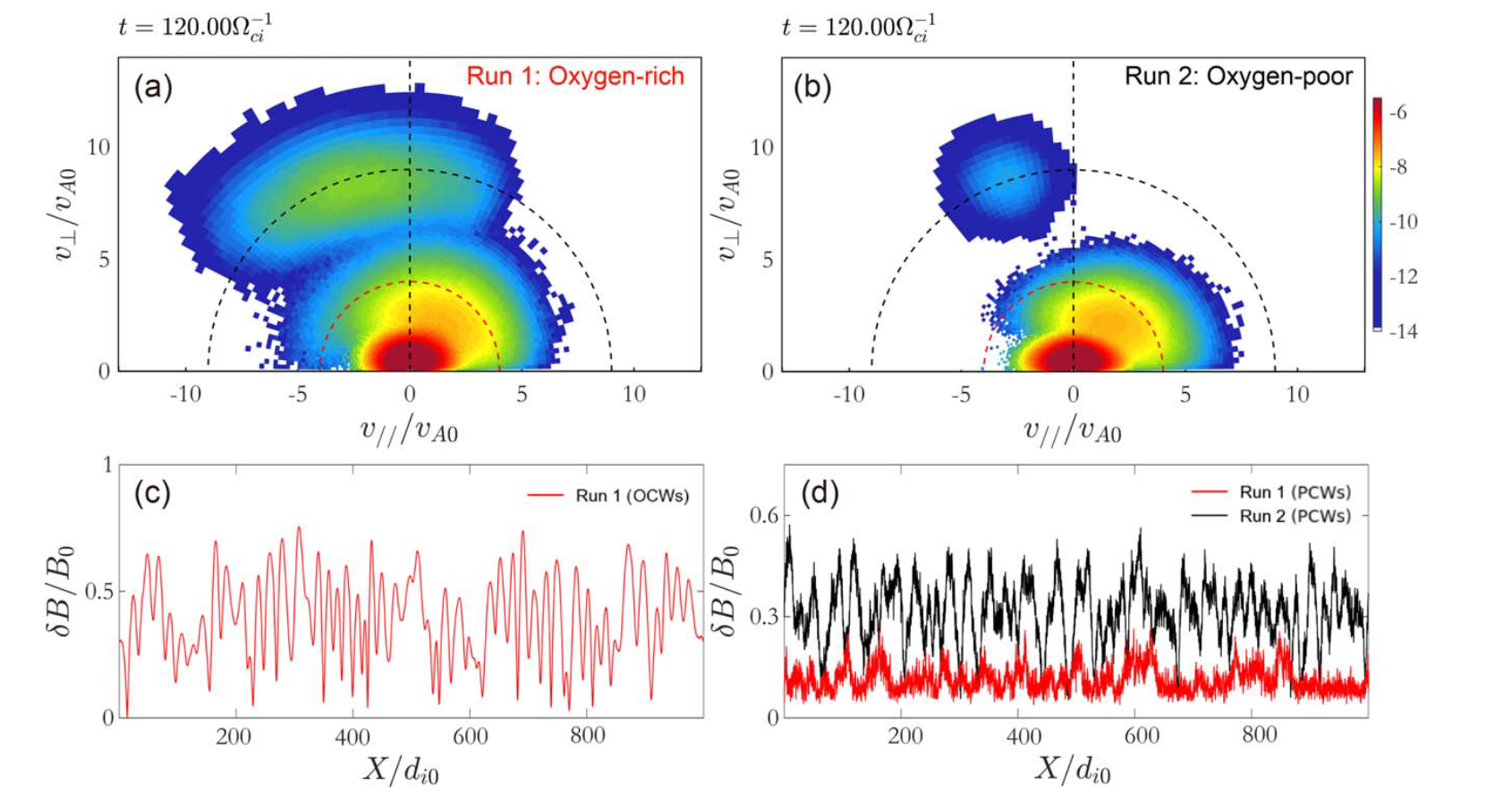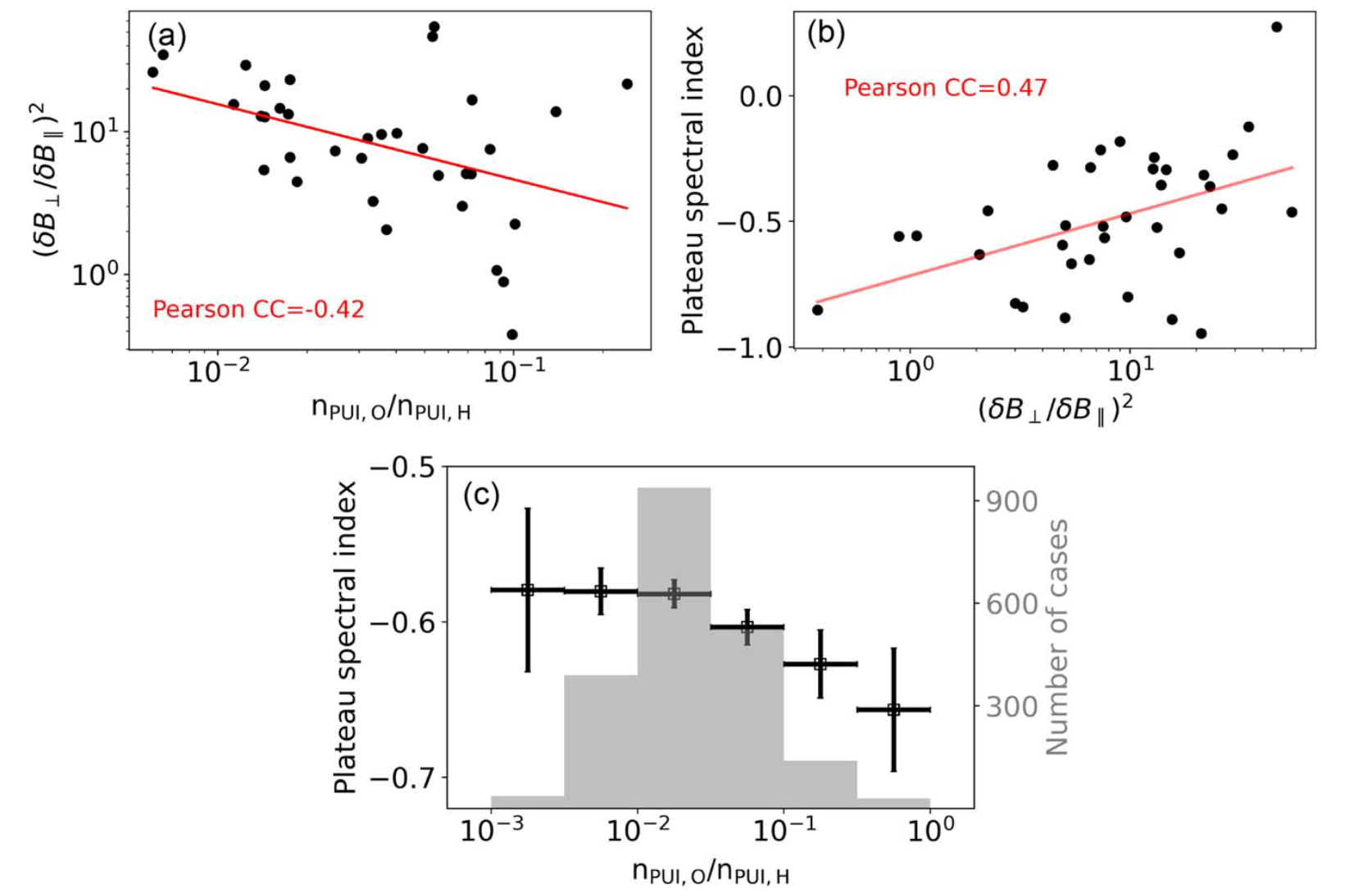Research reveals turbulence at Mars modulated by pickup ions instabilities
Due to Mars' weak global magnetic field, solar wind interacts directly with its atmosphere, generating abundant "pickup ions" through interactions with escaping neutral material. Neutral components escaping from Mars create H+ and O+ pickup ions mainly through charge exchange with solar wind plasma. These ions are accelerated by the solar wind's electric field, forming a ring-beam distribution in velocity space. Deviating from Maxwellian distribution, the ring-beam's velocity function is unstable and can trigger electromagnetic waves like proton cyclotron waves. Mars' weak magnetic field leads to a smaller spatial scale downstream of the bow shock compared to Earth. Unlike Earth's Kolmogorov turbulence, Mars' magnetosheath shows a "plateau-like" power spectrum. Recent studies link this phenomenon to pickup ion parameters, but the exact modulation mechanism remains unclear. MAVEN and Tianwen-1 data offer insights into the turbulent nature of Mars' magnetosheath.
Recently, Professor Li, Hui and Dr. Jiang, Wence, along with collaborators from the Key Laboratory of Solar Activity and Space Weather, led by Academician Prof. Wang, Chi, conducted case studies and statistical research on the instability of pickup ions based on high-resolution ion distribution functions provided by the MAVEN satellite. The team analyzed a typical event of the "plateau spectrum" in the Martian magnetosheath in detail (Figure 1) and discovered that the properties of pickup oxygen ions (O+) in the Martian space environment significantly modulate the spectral index of the "plateau spectrum." Further analysis of the properties of pickup ions in velocity space during this period revealed the simultaneous presence of two types of pickup ions (H+ and O+) exhibiting completely different ring-beam morphology characteristics in velocity space (Figure 2). Further analysis combined with PIC simulations (Figure 3) suggested that background proton cyclotron waves may be the main mechanism leading to an increase in magnetic field energy in the "plateau" region of the "plateau spectrum", which is excited by unstable pickup protons (H+). The properties of the proton cyclotron waves excited by pickup protons are modulated by the inhomogeneous distribution of pickup oxygen ions, affecting the abundance of pickup oxygen ions (O+). Further analysis of MAVEN observations from 2015-2019 confirmed the proposed physical mechanism, indicating that when the density of heavier pickup O+ ions is higher, the instability caused by pickup H+ ions is suppressed, leading to a decrease in magnetic field disturbance energy and a change in magnetic field power spectrum index.
This study reveals the modulation characteristics of the unique "plateau-like" power-law spectrum of magnetic field disturbances in the Martian magnetosheath by background pickup ion parameters and provides a possible physical mechanism explanation through numerical simulation work. The research paper has been published in the international academic journal "The Astrophysical Journal".
Article detail:Li, H.*, Jiang, W.*, Yang, Z., Liu, X., Verscharen, D., & Wang, C. (2024). Pickup Ion Modulation on Plateau-like Turbulence in the Martian Magnetosheath. The Astrophysical Journal, 967, 76 (2024). https://iopscience.iop.org/article/10.3847/1538-4357/ad3d49

Figure 1, MAVEN observation of the Martian magnetosheath crossing event on May 9, 2016. (a) Magnetic field in MSO coordinates. (b) Ion number density from SWIA. (c) Ion velocities in MSO coordinates. (d) Wave normal angle. (e) Ellipticity. (f) Compensated spectrum of magnetic field PSD. (g) Magnetic field PSD. (h) Schematic diagram of MAVEN satellite position.

Figure 2: (a) and (b) Ion velocity distribution functions observed by SWIA during two periods with high and low oxygen abundance in the case study. Dashed semi-circles represent the estimated maximum energy of pickup ions H+ (in red). (c) and (d) Time series of magnetic field perturbations observed in the perpendicular direction. (e) and (f) Diagram of magnetic field disturbances in the plane of the MVA coordinate system.

Figure 3: (a) and (b) Ion velocity distribution functions observed by SWIA during two periods with high and low oxygen abundance corresponding to the PIC numerical simulations in the case study. (c) and (d) Time series of vertical magnetic field perturbations observed in the oxygen cyclotron wave frequency band and proton cyclotron wave frequency band in the numerical simulations.

Figure 4: (a) Statistical distribution of magnetic-field power of the typical "plateau spectrum" observed by MAVEN and the density ratio of pickup oxygen ions to pickup protons. (b) Statistical distribution of spectral index of the typical "plateau spectrum" and magnetic-field power. (c) Statistical distribution of spectral index of the "plateau spectrum" observed by MAVEN from 2015 to 2019 and the density ratio of background pickup oxygen ions to pickup protons.


